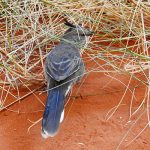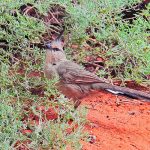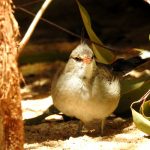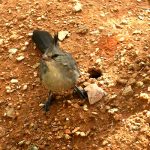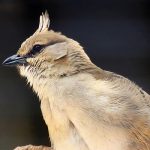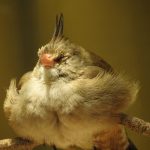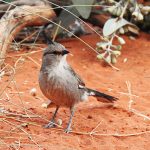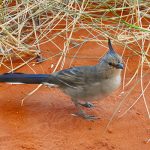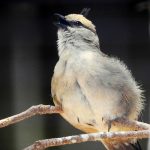CHIMING WEDGEBILL
Sharon: The Chiming Wedgebill has a very repetitious song which sounds like a bell chiming, ala his name. Have a listen 🙂
The Chiming Wedgebill (Psophodes occidentalis)
Deep in the arid heartlands of Australia, a unique bird adds its melodic voice to the landscape: the Chiming Wedgebill. With its distinctive call and secretive habits, this species offers a fascinating glimpse into the subtle beauty of Australian birdlife.
Physical Description
- Size: About 20–22 cm in length, roughly the size of a blackbird.
- Appearance:
- Dull brown upperparts with a paler, creamy underside.
- A wedge-shaped tail, which it often flicks expressively.
- Strong, slightly curved bill adapted for foraging on the ground.
- Sexes: Males and females look alike, making them difficult to tell apart at a glance.
Habitat and Distribution
- Location: Endemic to inland Australia, particularly in the western and central regions.
- Habitat:
- Prefers dry, open shrublands and acacia scrub.
- Often found in mulga and saltbush country.
- Adaptations: Well-suited to life in arid and semi-arid environments, relying on sparse vegetation for cover.
Behaviour and Diet
- Feeding:
- Forages mainly on the ground.
- Diet consists of insects, seeds, and small invertebrates.
- Daily Rhythm: Most active during the cooler parts of the day—early morning and late afternoon.
Vocalisation
- Signature Call: The chiming wedgebill is named for its distinctive, clear, ringing call—often described as “chime-like.”
- Duet Singing:
- Pairs often call together in a duet, with the male producing a loud “chime” and the female answering with a softer note.
- The duet plays an important role in pair bonding and territory defence.
- Acoustic Landscape: In the stillness of the Australian outback, their calls can carry for several hundred metres, adding a musical element to the bush.
Breeding and Life Cycle
- Nesting:
- Builds a neat, cup-shaped nest in low shrubs.
- Lays 2–3 eggs, which are incubated by both parents.
- Chick Rearing: Both parents share feeding duties, ensuring high survival rates for their young in harsh conditions.
Interesting Facts
- Elusive by Nature: The chiming wedgebill is more often heard than seen, as it prefers to stay hidden in dense shrubs.
- Territorial Duets: Their duet singing is so tightly synchronised that it can be mistaken for a single bird.
- Disease Resistance: Their adaptation to arid habitats means they are less susceptible to some diseases that affect birds in wetter regions.
- Confusion with Cousin: They are closely related to the Chirruping Wedgebill (Psophodes cristatus) but their calls are quite different, helping birdwatchers distinguish between them.
- Cultural Significance: The unique call of the chiming wedgebill has become a memorable feature for many who have spent time in the Australian outback, symbolising the resilience and distinctiveness of Australia’s inland environments.
Conservation Status
- IUCN Status: Currently listed as Least Concern, but populations can be affected by habitat loss through land clearing and overgrazing.
- Conservation Message: Protecting native shrubland habitats is crucial for the ongoing survival of this species and the rich diversity of life that depends on these environments.
The Chiming Wedgebill stands as a testament to the wonders of adaptation and the hidden beauty of Australia’s arid regions. Its song, echoing through the bush, serves as a gentle reminder of the importance of preserving these unique landscapes for future generations to experience and enjoy.
Let the chiming wedgebill’s voice inspire us to listen more closely to nature—and to protect the wild places that still sing with life.

